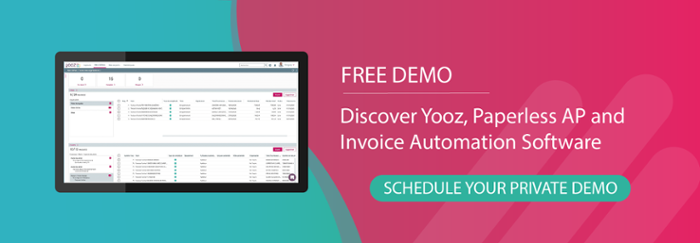To say that Covid-19 had a big impact on Small and Medium Sized Enterprises (SMEs) is an understatement. With the first wave of lockdowns, many businesses were plunged into crisis mode almost overnight and forced to dramatically adapt their working practices.
When the pandemic first hit, the daily tasks that employees typically did in the office had to be done from their homes. From supplier to customer, order to procurement, and even to delivery, many businesses were simply not set up for a long-term remote work environment in any department. This is especially true for smaller companies and their finance teams, where the move away from the physical workplace highlighted the impracticality of continuing with a manual accounts payable automation system. It was clear that change would be needed not only to thrive but even just to survive.
Simply put, maintaining paper-based processes when your employees are working remotely is not a good solution for any business, large or small. For example, if paper invoices are going to your business address but either no one is picking them up or somebody is only collecting them sporadically, then what is the approval process and how are they being paid on time? What process is in place to ensure good communication between teams, financial or accounting accuracy, and information security? What tool or system is management using to track the documents?
While many organizations came up with creative ways to get around such issues, if continued remote working is going to be the ‘new normal’ then companies of all sizes need to think more strategically about a solid long term process solution. Based on available data, this is the case: the trend for distance working appears to be here to stay. In a survey of nearly 1,000 company directors by the Institute of Directors in September, 74% said that their firms would be continuing with increased working from home after the pandemic.[1]
Increased digitalization for small businesses
For many firms, the introduction of offsite working processes and the need to adjust their existing paper-based solution has meant increasing their level of digitalization. The 2020 Harvey Nash/KPMG CIO Survey reported that of 4,200 IT leaders surveyed globally, almost half felt that COVID permanently accelerated their company’s digital transformation and adoption of emerging technologies including artificial intelligence, machine learning, blockchain and automation.[2] A separate study of 4,600 remote working employees of SMEs by Capterra in April found that new software had been, or was going to be, bought to help them adapt to their new work environment. The survey also found that companies were increasingly switching to cloud technologies instead of on-premises, with 39% having already made the change to facilitate remote working.[3]
Many of the working practice changes will have been an initial rushed reaction while companies originally just focused on being operational. But by now, most companies have moved beyond the initial crisis phase and are starting to think more strategically about the lessons learned from the events of the past year. Based on available data it is no longer a question of surviving the moment but rather, surviving and thriving long-term.
For example, according to the SME Finance Monitor Q32020 prepared by BVA BDRC, while about 75% of SMEs said they had been negatively impacted by Covid, 57% believe the worst is now behind them.[4] This is giving companies the ability to shift their focus to planning. The same survey found that four in 10 SMEs are now focusing on the long term, with just 25% still occupied with dealing with the immediate impact of the pandemic.
What does the future look like? For many companies, the only sure thing is change.
Automated accounts payable for small businesses
Assuming your business is among those that plan to stick with telecommuting in the post-Covid-19 world - and most are in some form - it's probably clear that paper-based processes need to change. One of the highest impact departments that typically use such processes is finance, specifically accounts payable. Simply put, if you're still using a manual account processing system it's time to automate.
The reality is that automated accounts payable software has long provided an opportunity for businesses to reduce their costs. From needing less storage to a reduction in paper (yes, paper!), elimination of on-site equipment and maintenance, and of course the ability to reassign employees to more strategic tasks... And these are just the tangible basics.
By freeing up the staff to do more important tasks there is an immediate improvement in productivity. By streamlining the invoice approval process using technology, there is also a drastic reduction in the risk of human errors and a significant increase in fraud detection capabilities. From procurement to payment, end to end, increased confidence and goodwill is built and maintained between vendor, company, and customer.
Because of such opportunities, over the past 20 years many enterprise-level businesses have already embraced such software and automated their accounts payable processes. Pre-pandemic, before circumstances forced change, the rationale for digitizing accounts payable for a small business was perhaps less compelling in comparison. Cost, required implementation time, worry that such a system would increase the risk of fraud or that the software would throw up too many exceptions were all concerns that resulted in many SME pushing automation to the bottom of their to-do list.
Today these fears are largely unfounded. Advancements in artificial intelligence and economies of scale, invoice and payment processing software are now accessible to companies of all sizes. In fact, unlike some of the other software changes that became necessary due to the pandemic, investing in accounts payable software should save the business money rather than cost it additional funds.
Specifically, on average, by replacing a manual AP invoice and payment process with cloud-based P2P automation software such as Yooz, one could reduce the cost per invoice by up to 70%. If you consider that the estimated cost of processing an invoice manually is between £9 and £20 (according to studies by analyst firms such as Aberdeen, Arthur D. Little, BVA, IOFM and Levvel) even just 100 monthly invoices represent up to £22,000 per year in invoice cost savings just by switching over to AP automation software.
The benefits are clear. An affordable, simplified, and secure process achieved through automation will not only help SME's to survive, but it also provides an easy way for companies to manage and thrive into the future.
In this webinar with Chartered Institute of Management Accountants (CIMA), find out how adopting Yooz, the most powerful real-time AP automation technologies, could help you increase your productivity, reduce financial risks, avoid late payments and guarantee regulation compliance.

.jpg)






